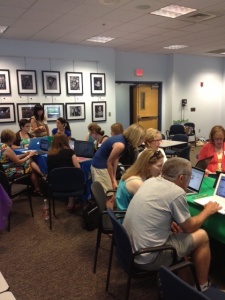Picture this:
It’s Tuesday afternoon and through the end-of-the-school-day-rush, you’ve finally made it to the school’s conference room to join your fellow co-workers. As you sit, you begin to hear:
A) “My last period class seemed to be really dragging today. I just wish I could somehow bottle up some energy from my 3rd period class.”
B) “Lunch duty was definitely interesting today… we had a serious pile up that should have been on Channel 10. There were SIX, yes S-I-X, spilled trays within the first 2 minutes.”
C) “I hope we get out of here early.”
You respond with, “Wasn’t this supposed to start 5 minutes ago?” and right on cue, the presenter begins.
As you scan the room you see (Check all that apply):
√ Pockets of side conversation
√ Smart phones discreetly hidden under the table being used
√ Smart phones not being discreetly hidden under the table…being used
√ Adults correcting paperwork
√ Passive participation
Pop Quiz:
Q: Where are you?
A: You’ve got it…PD.
Now, don’t get me wrong – we’ve all been to fabulous professional development and not every meeting looks the way I described it above. However, in many cases, the scenario drawn out above is exactly how PD is being presented.
Sooo, the big questions: What makes PD effective? What makes it exciting to go to? How can we tap into the power of PD?
I made a quick list that I think captures some key points:
Norms
Norms help keep everyone accountable for their time and learning (and the time/learning of others). It’s always better to set the stage from the get-go instead of back peddling as soon as the phones come out. I stole some of my favorite meeting norms from many of the NTC (@NewTeacherCtr) PDs I’ve been to this year:
Confidentiality
Equity of Voice
Active Listening
Safety to Share
Self Monitored Use of Technology
Commitment to the Work
Participant Centered
This is huge. Real learning comes from conversations and tinkering around with new information – so, it’s vital that participants do the heavy lifting in sessions. I know that listening to someone lecture (I always have a negative visceral reaction to that word) won’t get new content to stick. We need to be delivering PD with best practice! (Activities, scenarios, role-plays, mini-video clips…) Educators need time to implement new learning – so allow time for participants to actively engage in doing so!
Relevant
It’s critical to have instructional outcomes for PD. What should participants be able to walk away with? How will that meaningfully drive their instruction for students? Make sure the topic hits upon needs and interests of participants – consider giving participants a survey or setting up a Padlet.
(If you are not familiar with Padlet, it’s a mini online bulletin board that could be used to brainstorm ideas. Here’s an example from an UNconference I’m helping to plan in August… My colleague put this one together for it: Gino’s Padlet)
Differentiated
Also, I guarantee no one wants to sit through an hour (or more!) of something they already know. We need to tap into the expertise of the adult learners that are in sessions. Consider open-ended work products or stations for participants to choose from. One size doesn’t fit all in the classroom, and we need to remember that when it comes to adult learning too!
Useable
The best professional development is the type that can be implemented the next day or that sparks you to learn even more. When PD is given in isolated bursts, it’s hard to make lasting and meaningful change. This is why either follow-up activities or timelines helps make everyone accountable. (Have post-it notes with a chart paper in faculty rooms or by teacher mailboxes: “Here are three strategies we learned about today… Try out one this week and post a mini-reflection of how it went on this chart paper. This way, we can continue to learn from one another.”)
Of course this is just a quick list of what I consider key points in facilitating professional development – but – I’d love to hear other’s perspectives and ideas!
Tying it all together
If that^ tease sparked your interest for information on UNconferences, please feel free to check out some of these resources:
What is an EdCamp Video
Professional Development for Educators by Educators: The Inspirational EdCamp Model (@ScottRRocco)
And (of course) here’s a shameless plug if you’re in the area and want to attend our UNconference EdTech2 August 2nd, HERE are the details.


